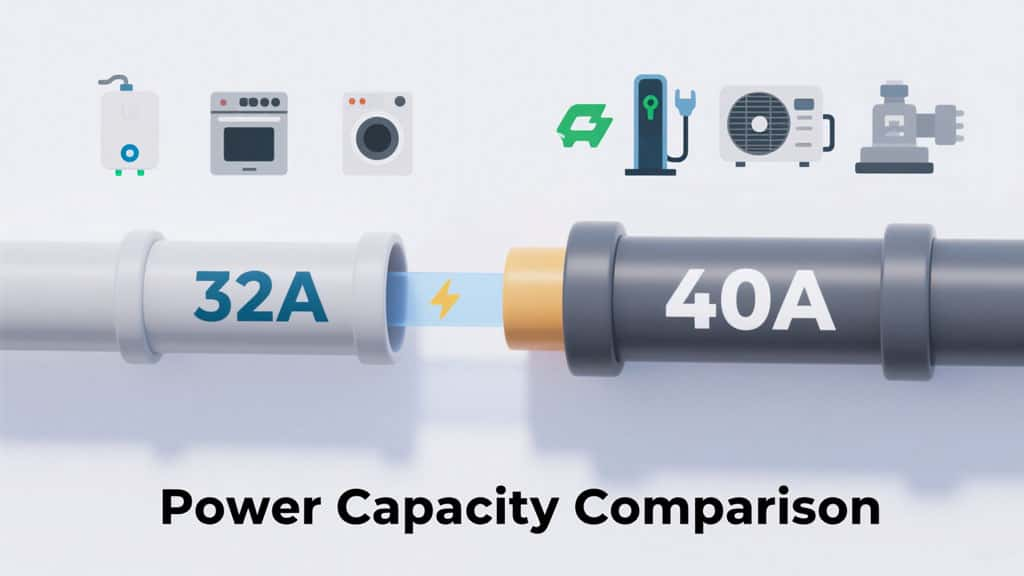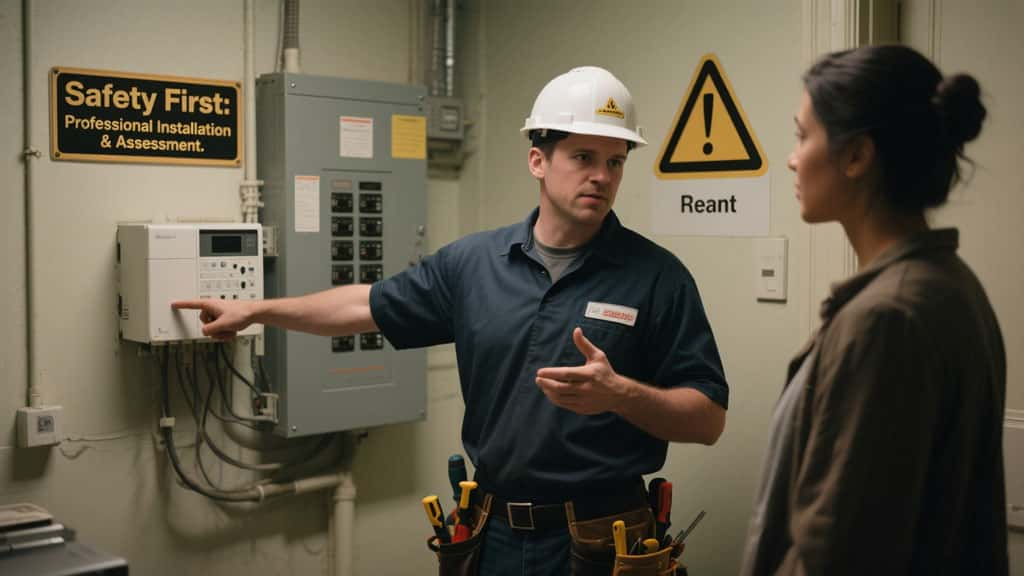In today's world of rising electric vehicle adoption, selecting the appropriate current carrying capacity for your home charging station is more crucial than ever. Are you grappling with the decision between 32 Amp vs. 40 Amp, unsure which amperage is the ideal choice for your electrical system? This isn't merely a numerical difference; it directly impacts your charging speed, installation budget, and long-term safety.
Whether you're planning your first home EV charging setup, upgrading your electrical panel, or simply comparing electrician quotes, understanding the unique characteristics of both 32 Amp and 40 Amp is paramount. We'll delve into the distinctions between the two, covering aspects like power handling, wiring requirements, and cost-effectiveness. This will help you clearly discern when choosing 32 Amp is more economical, and when 40 Amp represents a wise investment for your high-power needs.
Table Of Contents
The Relationship Between Amps, Watts, and Volts
To truly understand how electricity works, it's helpful to know how Amps, Watts, and Volts connect. Volts represent the electrical "pressure" or force that pushes the current. Amps measure the volume of that current. Watts, on the other hand, measure the actual power consumed or produced by an electrical device.
These three are linked by a simple rule known as Ohm's Law. In basic terms, power (Watts) equals voltage (Volts) multiplied by current (Amps). For instance, a 240-volt circuit with 32 amps delivers roughly 7.6 kW of power. Knowing this helps you understand why higher amperage results in faster charging speeds.
32 Amp Explained: Common Uses and Key Advantages
Let's break down 32 Amp circuits. These are the "sweet spot" for many residential electrical setups. A 32-amp charging setup handles a good amount of power while often avoiding the need for expensive service upgrades.
Common 32 Amp Applications You'll find 32-amp circuits powering many everyday items in your home. They're often used for dedicated circuits that need more power than a standard outlet.
•Electric Vehicle (EV) Level 2 Charging: This is the most common standard for home charging, typically delivering 20-25 miles of range per hour.
•Electric Clothes Dryers: Standard electric dryers typically fall within the 30-amp range.
•Water Heater Circuit: Many standard electric water heaters are perfectly suited for this circuit size.
32 Amp's Cost-Effectiveness & Wiring nuances Choosing a 32-amp charger is often the most cost-effective strategy for existing homes.
•Wire Gauge & Type: A 32A charger requires a 40A breaker. According to NEC Table 310.16, 8 AWG NM-B (Romex) copper cable is sufficient because it is rated for 40 Amps at the 60°C column. This is significantly cheaper and more flexible than the 6 AWG NM-B wire typically required for a 40A charger (which needs a 50A breaker).
•Conduit Installation: If using individual conductors (THHN/THWN-2) in conduit, 8 AWG is still sufficient, but the cost savings primarily come from avoiding the jump to the heavier 6 AWG required for higher amperage setups in residential wiring (NM-B).
40 Amp Explained: High Power Needs and Future Considerations
Now, let's explore 40 Amp charging. These are designed for higher power demands and are becoming increasingly common with newer, long-range EVs.
The Importance of 40 Amp in Electric Vehicle Charging One of the most significant roles for a 40-amp circuit today is in faster Level 2 charging.
•Faster Charging Speeds: A Level 2 EV charger drawing 40 continuous amps can typically add about 30-32 miles of range per hour.
•Future-Proofing: As EV battery capacities grow (like in electric trucks or SUVs), having a higher amperage setup ensures you can recharge a massive battery overnight without issue.
32 Amp vs. 40 Amp: Key Performance Indicators Comparison
32 Amp vs. 40 Amp: Technical Specification Breakdown To verify which setup fits your panel, refer to the comparison below based on standard 240V residential service:
| Feature | 32 Amp Charger | 40 Amp Charger |
| Charging Power | 7.7 kW | 9.6 kW |
| Range Added Per Hour | ~25 miles (40 km) | ~32 miles (51 km) |
| Required Breaker Size | 40 Amp (2-pole) | 50 Amp (2-pole) |
| Continuous Load Rule | $32A \times 125\% = 40A$ | $40A \times 125\% = 50A$ |
| Min. Wire Size (NM-B/Romex) | 8 AWG Cu (Rated 40A @ 60°C) | 6 AWG Cu (Rated 55A @ 60°C) |
| Min. Wire Size (THHN in Conduit) | 8 AWG Cu | 8 AWG Cu (Rated 50A @ 75°C)* |
| Est. Wiring Cost Factor | Baseline ($) | ~1.5x - 2x Higher ($$) |
*Note: Using 8 AWG THHN for a 50A circuit requires verifying that terminals on both the breaker and charger are rated for 75°C.

⚠️Critical Safety Rule: The 125% Requirement (NEC Reference)
Electrical codes treat EV charging as a "Continuous Load" because the device runs at max current for 3 hours or more.
-
Code Citation: According to NEC Article 625.40 (Overcurrent Protection) and NEC 210.19(A)(1), the branch circuit conductors and overcurrent protection must be sized at no less than 125% of the noncontinuous load.
-
The Calculation:
32A Charger: 32A × 1.25 = 40A Breaker
40A Charger: 40A × 1.25 = 50A Breaker
-
Safety Warning: Using a 40A breaker for a 40A charger will cause nuisance tripping and overheat the breaker terminals, posing a significant fire hazard.
How to Choose: 32 Amp or 40 Amp? Your Decision Guide
The "Panel Saver" (Why Choose 32A?)
For a recent client living in a 1992 single-family home with a standard 100-amp main service, installing a high-power charger presented a significant financial hurdle. The homeowner wanted to charge a Tesla Model Y, but a mandatory NEC 220.87 Load Calculation revealed that their home's existing peak demand was already at 68 amps.
If we had installed a 40-amp charger (which requires a 50-amp breaker), the total calculated load would have spiked to 118 amps. This exceeds the main panel's safety rating and would have triggered a mandatory service upgrade costing between $2,500 and $4,000. Instead, we recommended a hardwired charger capped at 32 amps. By using a 40-amp breaker and standard 8/2 NM-B (Romex) wire, we kept the load within code limits. The client saved thousands of dollars and still gains about 25 miles of range per hour, which easily recovers their daily 40-mile commute in under two hours.
The "Big Battery" Need (Why Choose 40A?)
In contrast, we worked with a client who purchased a Ford F-150 Lightning with a massive 131 kWh extended-range battery. Since their home was a modern build (2018) with a 200-amp service, panel capacity was not an issue, but time was. Charging this massive battery at 32 amps (7.7 kW) would take over 13.5 hours to fill from 10% to 90%, which was too slow for the client’s back-to-back work shifts.
To solve this, we installed a 40-amp charger (9.6 kW), which cut the charging time down to roughly 10.5 hours, ensuring the truck was ready for work by 7:00 AM every morning. Crucially, this installation required upgrading the wiring to thicker 6/2 NM-B Copper. This is a vital safety detail: according to NEC 310.16, standard 8 AWG wire is only rated for 40 amps at the 60°C column and cannot legally be used with the 50-amp breaker required for this setup. While the material cost was higher, the extra power was essential for the client's heavy-duty usage.

Safety First: Installation and Usage Precautions
Regardless of whether you choose 32 Amp or 40 Amp, electrical safety must always be your top priority. Improper installation is the leading cause of residential electrical fires.
•Matching Components: Always ensure your circuit breaker matches the wire gauge and the appliance's requirements (following the 125% rule mentioned above).
•Overload Protection: Circuit breakers provide crucial overload protection. Never try to bypass or tamper with a circuit breaker.
•Proper Grounding: Ensure all circuits are correctly grounded. Grounding provides a safe path for electricity in case of a fault, protecting people from electric shock.
•Avoid DIY Unless Qualified: Unless you are a licensed electrician, avoid complex electrical DIY projects. The risks far outweigh any potential savings.
Making an Informed Choice for Your Electrical Needs
Choosing between 32 Amp vs. 40 Amp doesn't have to be a daunting task. By understanding your current electrical panel capacity and your daily driving needs, you can make the right decision.
Whether the best amperage for you is 32 Amp (for cost savings and older homes) or 40 Amp (for maximum speed and larger vehicles), an informed choice ensures both safety and optimal performance. Always prioritize professional consultation for installations and modifications to your electrical system.
Final Recommendation: Consult a Licensed Professional While this guide provides the technical foundation for choosing between 32A and 40A, every home's electrical grid is unique.
•Check Your Panel Label: Look for the amperage rating on your main breaker.
•Perform a Load Calculation: Ask your electrician to perform an NEC 220.82 load calculation before purchasing a charger.
DISCLAIMER: This article is for educational purposes only and references the National Electrical Code (NEC) 2023 standards. Local codes may vary. Always hire a licensed electrician for installation. High-voltage electricity is dangerous and lethal if mishandled.
Post time: Jul-23-2025


